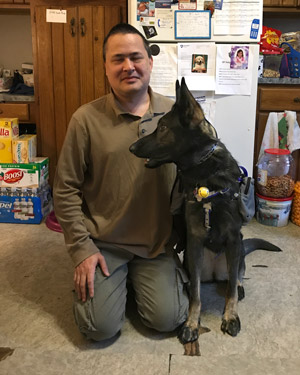Written by Buddy Brannan
Every so often, I hear a variation on this statement: “I think of my school guide dog ID like a driver’s license.” Or, “Getting your guide dog is sort of like getting a driver’s license.”
I’ve heard this for years, and I’ve always had some vague discomfort with it.
I wonder, why do people say this? Is it because we can’t actually have driver’s licenses and want something like that, so, hey, I’ll just say that this thing is like that? Is there some other reason? Is it because we have to learn to use a dog, or “drive” a dog? (Interestingly, I don’t think I’ve ever heard a cane user say anything like this, yet the training involved to use a cane effectively is just as intense. I digress.)
Recently, I’ve heard a resurgence in this notion as it relates to a push to combat the “fake service dog” problem, specifically by requiring some sort of officially recognized ID or certification. There’s a whole raft of problems associated with that, and I’d like to talk about those problems in a future post.
Before that, and believe me that will be a fairly involved narrative, I really want to address this whole driver’s license analogy. Put very simply, there is absolutely no parallel between the two, so please stop saying that there is.
Here’s the most important difference between using a guide dog and getting a driver’s license.
Having a guide dog is a right. Getting a driver’s license is a privilege. Read that carefully. No, going to a guide dog program and having that program match you with a dog is not a right. However, once you have a guide dog, whether you get one through a program or you get one privately trained or owner-train one, you do have the right to be accompanied by that guide dog. That is not a privilege, that is a right. While that right has limits, and they’re sensible limits, those limits do not make it any less a right.
Contrast that to getting a driver’s license.
You don’t just get one when you turn 16 (in most states, anyway). You can have your license pulled for any number of sensible reasons. You can have a license not granted for, again, any number of sensible reasons. You do not, therefore, have a right to a driver’s license. If you have a disability however, and if you can acquire an individually task-trained dog, you absolutely have the right to be accompanied by that individually task-trained service dog. While a service dog that is not properly trained or socialized, or is not under your control, can be removed from any establishment, which is to say that your rights are not absolute, there’s nothing stopping you from exercising the right to be accompanied by another dog, again assuming it’s properly behaved and under control. Not so if you lose your license—you can’t just get another one. Privilege vs. right.
Second, a driver’s license is issued by a state government.
Guide dog IDs, if you get one at all, are issued by the training program and, legally speaking, aren’t worth the plastic they’re printed on. Mind you, this may well change if some certification is implemented, but that’s how it stands today, and for my part, I’d like to keep it that way for a variety of reasons. Where there are specific legal reasons that you can be asked to show a driver’s license, many of those requirements can be as easily satisfied by a state-issued ID card, the thing I affectionately call a “passenger’s license”. Such cases include buying alcohol or tobacco, buying airline tickets, opening a checking account, and the like. Naturally, a passenger’s license won’t work for offenses committed while driving a car, and you do actually need a driver’s license for those.
In the theoretical case where some sort of government-issued service dog ID were issued, it still wouldn’t be the same as a driver’s license. As I said, there are very specific cases where someone can ask for your driver’s license. If a police officer pulls a driver over for speeding, s/he will ask for license, registration, and proof of insurance. If this same driver were to stop off at a store to buy a pack of cigarettes and a 12 pack of beer, s/he would likely be asked to show a license as proof of age. If this driver were to then catch a plane to Vegas, s/he would be asked to show a license to buy an airline ticket. The driver would not be asked to show ID when stopping off for a coffee, a hamburger, to return a library book, mail a letter at the post office, buy a shirt at Old Navy, go to a doctor’s appointment, pick the kids up from school, and pick up a gallon of milk and a loaf of bread on the way home. I can definitely envision being asked to show a guide dog ID for every single one of those errands. Imagine that being your day, every day. Or, put another way, imagine a police officer being able to stop a driver just to make sure s/he has a license, even if the driver gave absolutely no reason for the police officer to be suspicious and was breaking no traffic laws. Would it be fair or right to do that, on the chance that the police officer might catch an unlicensed driver?
The differences between the two are very clear. The only similarity, as someone once said, may be that you can apply for a guide dog when you turn 16. That’s about where the similarities end. Even if a government-issued ID became our reality, there’s still a world of difference.







